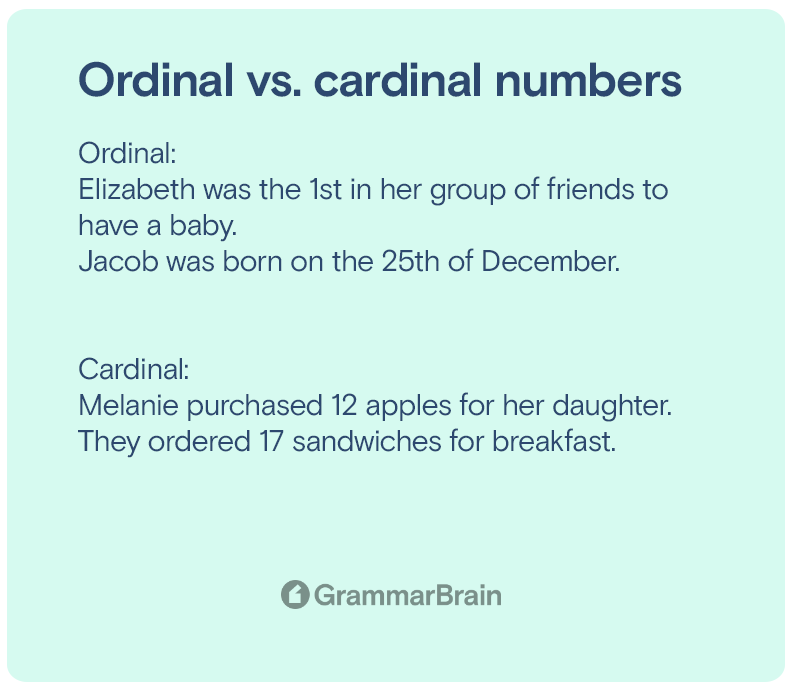Ordinal and cardinal numbers are quite confusing to most people. Though they come from the world of number theory, which is a sub-topic in the world of mathematics – they are also used in language.
A Polish mathematician named – Waclaw Sierpiński, wrote the famous book on ordinal and cardinal numbers in 1965, elucidating their importance in set theory.

What do ordinal & cardinal numbers mean?
Ordinal numbers give us the exact location of an object concerning other objects. For example, “They live on the 6th floor, two floors below us” – is a sentence that gives us the exact position of an object. So, ordinal numbers denote the position of an object but not its quantity or magnitude.
Cardinal numbers, on the other hand, provide the exact quantity or magnitude of an object. For example, if someone says – “There are 6 cars in my garage”, they are denoting the number of cars, here ‘6’ represents a cardinal number. So, cardinal numbers are mainly used for quantification purposes.
Cardinal numbers start from 1 and can go on endlessly, as 0 is not a counting number.
| Number | Definition |
| Cardinal number (noun) | a number denoting quantity (one, two, three, etc.), as opposed to an ordinal number (first, second, third, etc.). |
| Ordinal number (noun) | a number defining a thing’s position in a series, such as “first,” “second,” or “third.” Ordinal numbers are used as adjectives, nouns, and pronouns. |
Difference between Ordinal & Cardinal numbers
The key points of difference between these numbers are listed as follows:
- Cardinal numbers help us to quantify an object or its magnitude. At the same time, ordinal numbers help us denote an object’s location or position in a given space.
- Cardinal numbers represent the objective aspect of measurement and have a less practical use. At the same time, ordinal numbers represent the subjective aspect of measurement and have a more practical use.
- 1, 2, 3,…and so on are cardinal numbers. While 1st, 2nd, 3rd, 4th,…and so on – are ordinal numbers. So, all ordinal numbers have a suffix, while cardinal numbers don’t.
- We use cardinal numbers to measure objects based on utilities. While in the case of ordinal numbers, measurement is done based on rank.
- Example of a cardinal number – The boy rates the taste of tea to be 85 out of 100, while he rates coffee to be 65 out of 100.
- Example for ordinal number – The boy gets more satisfaction by tasting tea than coffee.
More examples of Ordinal & Cardinal numbers in sentences
Ordinal numbers:
- Elizabeth was the 1st in her group of friends to have a baby.
- Jacob was born on the 25th of December.
- I am going to my grandparent’s 50th wedding anniversary party on Sunday.
- Henry came 3rd in the painting competition and got the bronze medal.
- In the 15th century, the world was completely different.
Cardinal numbers:
- Melanie purchased 12 apples for her daughter.
- They ordered 17 sandwiches for breakfast.
- Jeremy wore jersey number 99 for the final match last Sunday.
- There are 366 days in a leap year and 365 days in a common year.
- Julio’s mother turns 80 next month.
Conclusion
Ordinal numbers denote an object’s place in a given arrangement of objects. Cardinal numbers are numbers that denote quantity. Both ordinal and cardinal numbers follow specific rules in terms of writing.
It is a usual mistake made by people when they say – “the number 10 floor” instead of saying – “the tenth floor.” Generally, people use cardinal numbers in place of ordinal numbers. Now that you understand the difference between the two, you can use them correctly while speaking and writing.
Inside this article
Fact checked:
Content is rigorously reviewed by a team of qualified and experienced fact checkers. Fact checkers review articles for factual accuracy, relevance, and timeliness. Learn more.
Core lessons
Glossary
- Abstract Noun
- Accusative Case
- Anecdote
- Antonym
- Active Sentence
- Adverb
- Adjective
- Allegory
- Alliteration
- Adjective Clause
- Adjective Phrase
- Ampersand
- Anastrophe
- Adverbial Clause
- Appositive Phrase
- Clause
- Compound Adjective
- Complex Sentence
- Compound Words
- Compound Predicate
- Common Noun
- Comparative Adjective
- Comparative and Superlative
- Compound Noun
- Compound Subject
- Compound Sentence
- Copular Verb
- Collective Noun
- Colloquialism
- Conciseness
- Consonance
- Conditional
- Concrete Noun
- Conjunction
- Conjugation
- Conditional Sentence
- Comma Splice
- Correlative Conjunction
- Coordinating Conjunction
- Coordinate Adjective
- Cumulative Adjective
- Dative Case
- Determiner
- Declarative Sentence
- Declarative Statement
- Direct Object Pronoun
- Direct Object
- Diction
- Diphthong
- Dangling Modifier
- Demonstrative Pronoun
- Demonstrative Adjective
- Direct Characterization
- Definite Article
- Doublespeak
- False Dilemma Fallacy
- Future Perfect Progressive
- Future Simple
- Future Perfect Continuous
- Future Perfect
- First Conditional
- Irregular Adjective
- Irregular Verb
- Imperative Sentence
- Indefinite Article
- Intransitive Verb
- Introductory Phrase
- Indefinite Pronoun
- Indirect Characterization
- Interrogative Sentence
- Intensive Pronoun
- Inanimate Object
- Indefinite Tense
- Infinitive Phrase
- Interjection
- Intensifier
- Infinitive
- Indicative Mood
- Participle
- Parallelism
- Prepositional Phrase
- Past Simple Tense
- Past Continuous Tense
- Past Perfect Tense
- Past Progressive Tense
- Present Simple Tense
- Present Perfect Tense
- Personal Pronoun
- Personification
- Persuasive Writing
- Parallel Structure
- Phrasal Verb
- Predicate Adjective
- Predicate Nominative
- Phonetic Language
- Plural Noun
- Punctuation
- Punctuation Marks
- Preposition
- Preposition of Place
- Parts of Speech
- Possessive Adjective
- Possessive Determiner
- Possessive Case
- Possessive Noun
- Proper Adjective
- Proper Noun
- Present Participle
- Prefix
- Predicate



